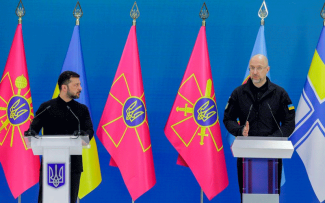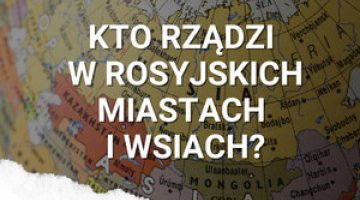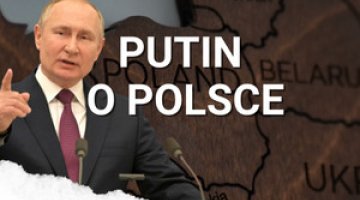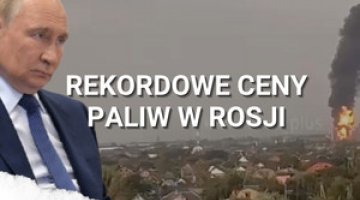Ukraine’s new defence minister. Day 1245 of the war

![]()
Russian troops intensified their offensive towards Pokrovsk and took over Pishchane and Zvirove, located to the south of the city. According to the Ukrainian media, Russia’s reconnaissance and diversionary groups infiltrated the town, taking advantage of the moment when Ukrainian forces were being rotated. The difficult situation is exacerbated by Russia’s advances north of Myrnohrad, where they are attempting to take control of the road leading to Dobropillia, which is the logistical centre and military base of the Ukrainians. The Russian army is making similar moves west of Pokrovsk, where it is leading an assault on Udachne and Kotlyne in an attempt to gain control of the E-50 Pavlohrad–Pokrovsk route.
Russia has also made a significant advance towards Novopavlivka on the border of the Dnipropetrovsk and Donetsk oblasts. It is thought that Russia has occupied Novomykolaivka and Kotlyarivka to the west of Novopavlivka and Piddubne, Yalta and Voskresenka to the south of Novopavlivka. This would mean that it has taken over territory with a total area of 9 km2 in the past week.
Russia continues its attempts to break through from the south towards Kostiantynivka in an attempt to bypass the Kleban-Bytske reservoir. Fierce battles are being fought over Yablunivka and Oleksandro-Kalynove, as well as Pleshchiivka and Katerynivka. Russia has achieved a limited success in the direction of Siversk, gaining control of Verkhniokamianske. It is also attempting to encircle Siversk – making advances in the area to the north (the seizure of Hryhorivka) and the south (the assaults on Pereizne). It has also achieved some success north of Sumy, where it is concentrating its efforts on the Yablunivka–Yunakivka–Sadky line, thus reaching the eastern part of the vast forest belt separating its forces from the oblast capital. Ukraine, meanwhile, is thought to have successfully counterattacked at Kindrativka and Andriivka north of Sumy.
![]()
On the night of 15–16 July, Russian forces carried out an air attack using one Iskander-M ballistic missile and 400 Shahed drones and their imitators. The main targets of the strike were energy and industrial infrastructure in Kryvyi Rih, Dnipro and Vinnytsia. In the latter, the Polish Barlinek Group plant was also hit, resulting in six people being injured, two of them seriously. The Ukrainian Air Force reported that 198 enemy drones were shot down that night, while 145 were neutralised by radio-electronic warfare systems.
Russia launched another massive air attack on the night of 18–19 July, using 12 Iskander-M/KN-23 ballistic missiles, eight Iskander-K and 15 Kh-101 cruise missiles, as well as 200 Shahed drones and 144 imitators. Ukraine reported it shot down a total of 208 of these means of aerial attack, including 185 drones, seven Iskander-M/KN-23s, seven Iskander-Ks and nine Kh-101s. Seven cruise missiles and 129 Shahed drones neutralised radio-electronic warfare systems. The Ukrainian Air Force communicated that five missiles and 30 drones struck 12 unspecified locations. Strikes on critical infrastructure facilities in Sumy and Odesa were confirmed.
A day later, the invaders launched a series of missile and drone attacks mainly targeting Kyiv, Kharkiv and Ivano-Frankivsk, which came under the most intense shelling since the full-scale invasion began. The Russians used 426 Shahed-type strike drones and their dummies and five Kh-46 Kinzhal missiles, four Kalibr missiles, one Iskander-K type and 14 Kh-101s. The Ukrainian Air Force reported that 200 Shaheds and 203 imitators were neutralisedand that all the missiles had been shot down. The targets of the attack were critical infrastructure and civilian facilities. The raid also damaged the entrance to the Lukianivska metro station in the capital. President Volodymyr Zelensky stated that 15 civilians were injured and two people were killed as a result of the strikes.
![]()
As part of the government reconstruction voted on by the Verkhovna Rada on 17 July, former Prime Minister Denys Shmyhal was appointed Defence Minister. In a special statement published after the new cabinet was constituted, the president instructed the new defence ministry head to ‘urgently conclude all drone contracts’ and to achieve a level of over 50% saturation of the armed forces with domestically produced equipment. In turn, in a speech to the Verkhovna Rada, Shmyhal announced the implementation of the ministry’s three main tasks: ensuring that military personnel are fully equipped to defend the country, increasing the amount of weapons and military equipment manufactured in Ukraine used at the front, and streamlining and increasing the efficiency of the ministry’s work.
Rustem Umerov, who hitherto held the post of defence minister, has been appointed secretary of the National Security and Defence Council. According to his statement, his commissioned tasks will include overseeing arms supplies and participating in peace negotiations with Russia. On the latter issue, he proposed a meeting between delegations from both countries in Istanbul on 23 July.
On the eve of the government’s reconstitution, the Verkhovna Rada adopted in the first reading an amendment to the budget law increasing military spending by 412 billion hryvnias (about $9.8 billion). The defence ministry will receive the lion’s share of these funds – 311 billion hryvnias ($7.4 billion). The change will bring defence funding to a total of 2.6 trillion hryvnias (about $62 billion), or 66% of all budget spending. As a result, the share of the defence sector in the projected GDP for this year will be around 31.1%, meaning that once again Ukraine ranks first in the world in this respect.
On 15 July, the Verkhovna Rada extended martial law for the 16th time, for another three months, until 5 November. “In favour” were 320 MPs, “against” – 1 (Oleksiy Honcharenko from the opposition European Solidarity party of former President Petro Poroshenko), and 16 did not take part in the vote.
![]()
On 21 July, participants in the 29th meeting of the Ukraine Defense Contact Group (UDCG) reaffirmed their earlier commitments, and some of them also revealed the details of new deliveries. The main topic was the support for air defence. Germany’s defence minister, Boris Pistorius, reiterated the announcement that Kyiv would receive two batteries of the Patriot medium-range air defence system, before adding that Kyiv needs at least five of them. Norway has decided to fund another, but it is unclear where the last two will be procured from. Germany will also be responsible for helping to coordinate the delivery of the Patriots (see ‘German military aid for Ukraine: a new model of support?’). The UK has said it has provided Kyiv with £150 million worth of anti-aircraft and artillery munitions in the past two months, and will provide an additional £700 million worth by the end of the year.
On 17 July, Latvian Defence Minister Andris Sprūds announced that 15 of the pledged 42 Patria 6×6 wheeled armoured personnel carriers had already been sent to Ukraine. On the same day, Belgium announced that it would contribute €140 million to Ukraine’s air defence as part of Germany’s Immediate Action on Air Defence (IAAD) initiative and would make its A400M transport aircraft available to support logistical operations for Kyiv.
On the same day, Switzerland announced that it had received a unilateral notification from the US to delay the delivery of the five Patriot air defence batteries contracted in 2022 due to the prioritisation of deliveries to Ukraine and countries supporting it.
Also on 17 July, the New York Post reported that Presidents Zelensky and Donald Trump were considering a deal that would include the purchase of US weapons in exchange for the sale of Ukrainian drones.
On 19 July, Australia’s Ministry of Defence reported that most of the 49 promised M1A1 SA Abrams tanks had already been delivered to Ukraine.
On 21 July, during a meeting with French Minister for Europe and Foreign Affairs Jean-Noël Barrot, President Zelensky announced (without providing details) that france companies had decided to start producing drones in Ukraine, and that Paris would intensify its efforts in air defence and the training of Ukrainian soldiers there.
As part of its annual report to the United Nations Register of Conventional Arms, Poland reported that in 2024 it had exported, among other things, 295 armoured combat vehicles, 10 D-44M cannons, 18 Krab howitzers, 78 2S1 Gvozdika howitzers, 28,500 anti-tank missiles (most likely for RPG-7), 15,000 hand grenades and 1,100 machine guns to Ukraine. This list includes only sold materiel – the Polish government’s unpaid military assistance remains classified.
![]()
According to the Commander-in-Chief of the Ukrainian Armed Forces, General Oleksandr Syrskyi, Russian troop losses on the Ukrainian front since the beginning of the year have averaged 1,251 soldiers per day (it is to be presumed that this refers to killed and wounded).
According to the Ukrainian monitoring group DeepState, the total length of enemy engineering and fortification fortifications is now 8,312 km. The calculation included areas in the Kursk, Belgorod and Bryansk oblasts, as well as fortifications seized from the Ukrainians as a result of advances at the front. Compared to November 2023, when the length of fortifications was estimated at more than 6,000 km, there has been a significant expansion, particularly in the Kharkiv (+350%) and Donetsk (+51%) oblasts. The largest number of fortifications is located in the Donetsk (2,814 km), Zaporizhzhia (1,991 km) and Luhansk (1,302 km) oblasts.
![]()
On 16 July, the Verkhovna Rada adopted a law increasing the size of the Security Service of Ukraine (SBU) from 27,000 to 37,000 personnel during peacetime and from 31,000 to 41,000 during martial law. In addition, the document provides for an increase in the number of soldiers of the SBU’s special ‘Alpha’ unit to 10,000. As reported by member of parliament and SBU Colonel Roman Kostenko, it is currently responsible for the destruction of around 10% of hostile targets and is involved in successful operations such as attacks on Russian refineries. The new regulations are intended to allow more volunteers, for whom there was previously a shortage of vacancies. The figure of 10,000 is to apply in both war and peacetime because, according to Kostenko, once hostilities are over, the war of the special services will begin.
Also on 16 July, the Verkhovna Rada passed a law allowing people over 60 to join the army on contract during martial law, provided they are deemed fit for service by a medical commission. Officer candidates must obtain the approval of the unit commander, approved by the General Staff of the Ukrainian Armed Forces. A two-month probationary period has been introduced, contracts will be for one year with the possibility of renewal, and will be automatically terminated when martial law ends.
On 17 July, the Coordinating Staff for the Treatment of Prisoners of War announced that the bodies of 1,000 people had been brought to Ukraine. According to the Russian side, these are Ukrainian citizens, including soldiers. The bodies will be identified and examined by law enforcement and Interior Ministry experts. Earlier, Russian remains were found among the alleged Ukrainian victims. Statements by Vladimir Medinsky – the Russian president’s plenipotentiary – indicate that Ukraine has handed over only 19 bodies to the Russian side in the exchange.
![]()
On 15 July, the SBU and the National Police of Ukraine captured six agents of the Federal Security Service (FSB) of the Russian Federation planning terrorist attacks on soldiers of the Ukrainian Defence Forces using explosives. They were all recruited by Russian special services through channels on Telegram. The detentions took place in Kyiv, Dnipro, Vinnytsia and Rivne.
![]()
On the night of 17–18 July, a drone attack took place in the village of Pervomaysky in Tula Oblast against the Shchekinoazot plant, which produces chemical products including substances used in the military sector. According to Russian reports, anti-aircraft defence units destroyed three drones, the debris of which caused a fire at the industrial facilities. According to Ukrainian sources, the strike allegedly paralysed the company’s work, including the production of methanol used to make rocket fuel and explosives.
On the night of 18–19 July, the Ukrainian Armed Forces carried out a massive drone strike on Russian territory. The Russians reported that the air defence forces intercepted and destroyed 73 enemy machines, of which 31 were shot down over Bryansk Oblast, 17 over Orlovsk, 10 over Moscow, four over occupied Crimea, three over the Sea of Azov, two each over the Belgorod and Nizhny Novgorod oblasts and one each over the Belgorod, Kaluga and Voronezh oblasts and the Black Sea. The consequences of the attack remain unknown. The following night, Ukrainian drones struck Moscow and localities in the Moscow and Kaluga oblasts. According to the capital’s mayor, Sergey Sobyanin, Russian air defence forces shot down 16 drones flying towards it, while the Russian Defence Ministry announced that 93 Ukrainian machines were shot down and intercepted, including 19 over the territory of Moscow Oblast.
On the night of 20–21 July, Ukrainian drones struck a railway station on the Kamenolomni settlement in Rostov Oblast, located 38 km from the Ukrainian border. The station is used as a logistics hub on the Rostov-on-Don–Taganrog–Donetsk route and plays an important role in the transport of military equipment.
Hackers from the groups BO Team and Ukrainian Cyber Alliance supported by Ukraine’s military intelligence is thought to have successfully attacked the network and server infrastructure of the Russian company Gaskar Integration – one of the main suppliers of drones to the Russian army. They gained access to more than 47 TB of technical data on the production of the drones, including information on cooperation with China. All information on the servers, including 10 TB of backups, was destroyed. The attack had the effect of crippling the internet, production and accounting programmes and the company’s development centre. The seized data includes confidential employee questionnaires and the full technical documentation of drone production, which was handed over to specialists from the Ukrainian Defence Forces.






